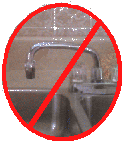 How It Works
How It Works How It Works
How It Works
The Drinking Water Systems are designed and engineered to provide the consumer the utmost in performance, safety, and convenience. The replaceable triple-action filter has been formulated of materials approved by the U. S. Food and Drug Administration to provide the highest quality drinking water without removing the healthful, natural minerals. The filter media combines mechanical filtration, electrokinetic adsorption, and physical adsorption to provide the most efficient contaminant removal possible.
Water enters the filter through a graded density pre-filter, a material of a special blend of refined cotton which acquires a positive molecular charge in a moving stream of water. Since most colloidal and bacterial contaminants exhibit a negative charge in solution, the media fibers electrokinetically adsorb charged colloidal particles too small for removal by mechanical straining. The media combines the technology of mechanical straining, for the removal and retention of solid and semi-solid contaminants that can cause premature clogging, and electrokinetic adsorption for the reduction of colloidal contaminants down to the sub-micron range.
Then the water passes through the highly compacted solid carbon block filter media which is a blend of selected activated carbons and polyethylenes. The compacted solid carbon block filter media is designed to mechanically filter particles down to sub-micron size, including microscopic organisms, asbestos, turbidity, and particulate matter. By microstraining the water, the consumer is assured that only the cleanest, clearest water is delivered to the point-of-use.
The components of the carbon block section of the filter are insoluble, and while themselves chemically inactive, some of the material exert a catalytic effect, inducing molecular changes in the many chemicals contained within the water. It is through this chemical reaction and physical adsorption that chlorine, certain pesticides, volatile organic chemicals, and dissolved lead are removed.
The solid carbon block filters are exceptionally uniform and do not channel or bypass as conventional granular activated carbon (GAC) filters are known to do. Conventional GAC filters become incubators of bacteria, encouraging growth; however, the densely compacted filters eliminate this problem because there is no room for growth in the tightly compacted carbon.
Finally, the water passes through a pharmaceutical grade post-filter which provides integral strength to the carbon block section and prevents material degradation of the filter. The threaded polypropylene end caps seal the carbon block and assure the integrity of the seal between the filter and the housing.
The unique formulation of their solid carbon block filters provides for the removal of substances that cause water to taste or smell bad as well as reduce a wide range of contaminants of health concern, including lead, trihalomethanes, cysts, turbidity, asbestos, certain pesticides and volatile organic compounds. Filter life will vary in proportion to the amount of water used and the type and level of impurities in the water being processed. It is recommended that the filter be replaced when the first of the following occurs: (a) the unit's rated capacity is reached; (b) at least once a year; (c) the flow rate diminishes; (d) the filter becomes saturated with bad tastes and odors.